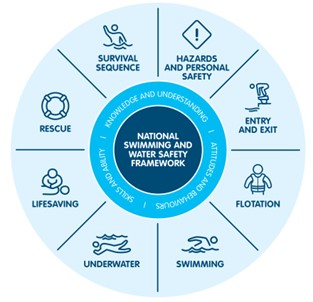RESEARCH AND ADVOCACY
Royal Life saving unifies drowning prevention efforts through research, advocacy and stakeholder collaboration
EDUCATION
Royal Life saving provides water safety education for the community, to ensure everyone knows how to participate safely around water.
SWIM TEACHERS AND SCHOOLS
Royal Life Saving supports swim teachers and schools with training, resources, and national standards to deliver safe, effective, and inclusive aquatic education.
LEARN TO SWIM
Royal Life Saving’s Learn to Swim programs build vital water safety and swimming skills that help prevent drowning and support lifelong confidence in the water.
Workforce development
Royal Life Saving brings stakeholders together to unify efforts, share expertise and deliver impactful solutions.
COURSES
Royal Life Saving offers a wide range of training courses suitable for community members and all levels of aquatic industry professionals.
LIFESAVING PROGRAMS
Royal Life Saving’s programs build rescue and resuscitation skills to help individuals respond confidently in aquatic emergencies.
LIFESAVING SPORT
Royal Life Saving offers members the opportunity to participate in Pool Lifesaving Sport at all skill levels.
ROYAL LIFE SAVING


National Framework
The National Swimming and Water Safety Framework supports a structured and consistent understanding of swimming and water safety education across Australia.

Background
Swimming is one of the joys of life. As well as being a vital life skill, the ability to swim opens up a raft of opportunities for people to enjoy a healthy, active and safe lifestyle and to confidently participate in aquatic recreational and sporting activities.
The National Swimming and Water Safety Framework's ultimate goal is to increase the swimming and water safety skills of all Australians for lifelong safe and active participation in physical aquatic activities and recreation.
It sets out a core structure to enable people to develop the skills, knowledge, understanding, attitudes and behaviours they need to enjoy a range of aquatic environments safely.
The Framework is intended for those that influence the learning opportunities and experiences for swimming and water safety education and guides those responsible for developing, providing or selecting a swimming and water safety program.
48%
Year 6 students below benchmark
31%
Schools without swim programs
59%
Children start lessons before age 3
75%
Cease lessons before age 9

Evidence Base for the Framework
Research into how swimming and water safety skills are attained has informed the development of the Framework.
Listen to the video to learn more about some of the key findings from the research that underpins the Framework and what it aims to achieve.
About the Framework
The Framework provides a progressive pathway through nine developmental milestones across eight subject-based strands, guiding children's learning and skill development in and around the water.
It is designed to support government policy makers and swim schools, while also serving as an important resource for parents to better understand the lifelong benefits of learning to swim.

Framework Stages
The Framework includes three key benchmarks at ages 6, 12, and 17 to support consistent assessment of swimming and water safety skills throughout childhood and adolescence.
National Benchmarks
The Framework includes three key benchmarks at ages 6, 12, and 17 to support consistent assessment of swimming and water safety skills throughout childhood and adolescence.








